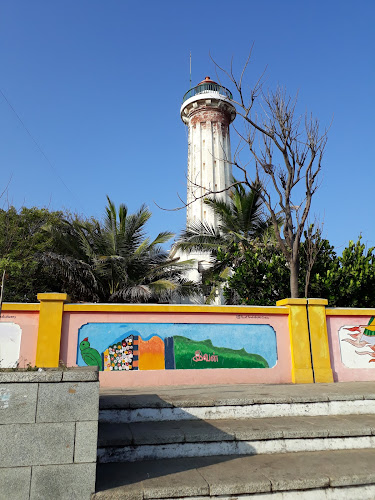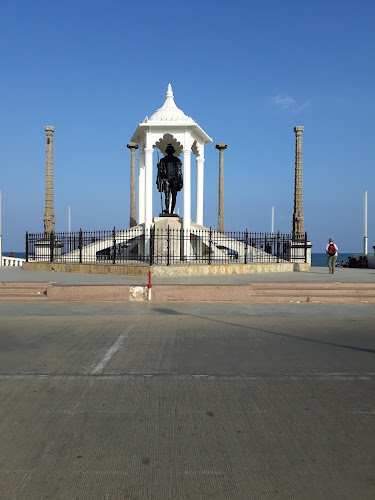We left from
Pondicherry is the capital city of The Union Territory of Puducherry and is one of the most popular tourist destinations in South India.
A French colony until 1954, this coastal town still has a number of imposing colonial buildings, churches, statues, and systematic town planning, as well as urban architecture of the local Tamil style - a unique mix of cultural heritage. The town has been referred to as 'The Europe of India'.
As we were driving, I was highly excited about visiting Pondicherry. If I have to let out a secret, I should admit that I (in fact my husband too) undertook this Tamil Nadu temple tour because it included Pondicherry in the itinerary. Well, what's so great about the place, you might ask. It's unforgettable for both of us, as we got engaged there, 48 years ago.
I have a greater association with the city. My father was posted there as the Director, PWD from 1969 to 1972. Our official residence was located on the first floor of the PWD Office building, Travaux Publics. I did my graduation from Tagore Arts College, Pondicherry. I got engaged and got married when I was in my final year; I joined my husband in Pune, after completing my final examinations.
I couldn't wait to visit 'our' house after 48 years ...... during the drive, my husband and I discussed about snatching an hour out of our itinerary for the visit .... we had already talked to our tour managers about our plan to take up the visit on our own .....
During our drive, we passed by towns like Vaitheeswaran Koil, Cuddalore ..... bringing memories of my visit to these places with my family .... those were the days.
As we entered Pondicherry, I had my eyes riveted on the scenes flitting past. What a change! So many malls, plazas, apartments, .....
We would check in at our hotel before 7 pm. I was dying to visit our 'house' at the earliest; the next day we should be able to snatch an hour in between .... the office might be working .... would we be able to make it to the house upstairs? .... Lot of 'ifs' and 'buts' ... My husband sensed my thoughts and suggested that we could go and visit the place soon after checking in. I was delighted.
We checked in at a nice place - Hotel Atithi. By the time our luggage arrived in our room, we had freshened up.
Then both of us embarked on our personal visit - to
Travaux Publics, where I stayed with my family during 1969 to 1972. In fact my engagement took place in that house. So both of us excitedly visited the place, located just a couple of kms from our hotel. Our day was made. Our tour was fruitful!
We came back and had a sumptuous dinner - literally a feast with a spread of desserts, including laddu, badusha, and jangiri.
Next morning, we woke early in the morning as usual. After getting ready, we decided to take a walk in the vicinity and if possible, explore the road lined up with theaters.
As it was Mahashivarathri that day, we went to the Shiva temple on the way.
We also went to a Vishnu temple nearby.
Then we continued to walk for some twenty minutes, but we did not come across any theaters, but we saw residences, malls and jewelry shops.
We returned to our hotel, in time for breakfast.
We left for Auroville - located half an hour away. It was nearing completion when I was in Pondy in the late 60's. We hadn't had a chance to visit it then.
Auroville has its origins in the French language, 'Aurore' meaning dawn and 'Ville' meaning city. Additionally, it is named after Sri Aurobindo, whose chief disciple was Mirra Alfassa (known as 'the Mother'). Auroville (City of Dawn), an experimental township in the Union Territory of Puducherry, was founded in 1968 by her and designed by architect Roger Anger.
As stated in the Mother's first public message in 1965, 'Auroville wants to be a universal town where men and women of all countries are able to live in peace and progressive harmony, above all creeds, all politics and all nationalities. The purpose of Auroville is to realize human unity.'
The inauguration ceremony attended by delegates of 124 nations was held on Wednesday 28 February 1968. Handwritten in French by the Mother, its four-point charter set forth her vision of integral living: Auroville belongs to nobody in particular. Auroville belongs to humanity as a whole. But to live in Auroville, one must be the willing servitor of the Divine Consciousness.
'Auroville will be the place of an unending education, of constant progress, and a youth that never ages.
Auroville wants to be the bridge between the past and the future.'
Although originally intended to house 50,000, the actual population today is 2,007, coming from 44 nationalities, 836 of whom are of Indian origin.
We had two hours at our disposal to look around the place.
It was a shaded walk,
with a lot of greenery around.
We saw the huge, ancient banyan tree, rooting itself through the many shoots.
We enjoyed the leisurely stroll around the place.
In the middle of Auroville is the
We could not go inside, as only those who are really keen on meditation have to register on line in advance for entry passes. Casual visitors are not allowed. Silence has to be maintained inside the place to ensure the tranquility of the space.
Inside, there is a spiraling ramp leading upwards to an air-conditioned chamber of polished white marble referred to as 'a place to find one's consciousness'. We were informed that Matrimandir is equipped with a solar power plant. When there is no sun or after the sunset, the sun's rays on the globe is replaced by a beam from a solar-powered light.
The entire area surrounding the Matrimandir is called the Peace area and has attractive manicured gardens.
We saw many visitors sitting and meditating. Nobody spoke, thus maintaining the unpolluted silence prevailing there. We too relaxed and sat in meditation for some time and enjoyed the bliss of calm, peace, and solitude.
We were told that a road leads directly to Auroville's private beach called Repos, several hundred meters away.
Our next halt was at Basilica of the Sacred Heart of Jesus, an oriental specimen of Gothic architecture. It is an imposing white-and-brown structure, supposed to have been erected in the 18th century by French Missionaries.
We entered the majestic church.
Service was going on. We too sat in prayer for a few minutes.
This Catholic Church has rare stained glass panels depicting events from the life of Christ. This old Church has been fully renovated both inside and outside after 2005.
As we came out, we saw a train passing by and noticed the railway station on the opposite side of the road. We remembered the few times, when our family had come to see my husband off to Pune, via Chennai, after visiting us. There was no direct train to Mumbai from there.
Other notable churches in the city are The Cathedral of Our Lady of the Immaculate Conception and The Eglise de Notre Dame des Anges (The Church of Our Lady of Angels), which we did not visit. We were also told that Meeran mosque, built over 350 years ago, is the oldest mosque in Pondicherry.
The evening agenda saw us visiting Aurobindo Paper factory, located close to our hotel.
We visited the samadhi of Sri Arobindo. (Pic courtesy - By Rameshng at Malayalam Wikipedia). Photography was strictly prohibited.
Absolute silence had to be maintained. The garden was abloom with lovely flowers.
Next was the visit to the famous Sri Manakula Vinayagar Temple, which was in existence before the French came and settled in Pondicherry - before 1666.
It has a golden spire and walls portraying forty different forms of Ganesha.
The ceiling has an exquisite painting of the marriage of Ganesha.
The temple also has a smaller shrine dedicated to Lord Murugan, who is Ganesha’s younger brother. Over 5000 devotees flock to this site everyday.
There is also a temple elephant, Lakshmi, who gives blessings to the devotees.
We also got her blessings.
From the temple, we walked to The Government Park or Bharathi Park,
in the green center of the town. The Government Park is aptly located in the central region of the old colonial town, which was known as the 'white town'. The significance of this park is that it is surrounded by some of the most important government buildings like the Lt. Governor's Palace, the Legislative Assembly, Government Hospital, Ashram Dining Room, the Cercle de Pondichéry private club, and the old Hotel Qualité. I would like to add that my father's official residence, above the PWD Office, Travaux Public, was also located in the vicinity, a few meters from the Government hospital.
Aayi Mandapam (Park Monument) situated in center of Bharathi Park, is a white monument built during the time of Napoleon III, Emperor of the France. The monument commemorates the provision of water to the French city during his reign. It was named after a lady courtesan called Ayi. She destroyed her own house to erect a water reservoir to supply water for the city.
Rock Beach (also known as 'Pondicherry Beach') is the popular stretch of beachfront in the city of Pondicherry, along the Bay of Bengal.
We could see the lighthouse at one end of the beach.
The beach, a 1.2-kilometre-long stretch, starts from War Memorial and ends at Dupleix Park. What I remembered were the daily driving lessons my brother and I would have from our driver early in the mornings during summer vacation - along this beach road. We would drag our kid sister too - she'd choose to catch up her sleep, lying on the back seat! That was so long ago.
Gandhi Statue is a four-meter statue of Mahatma Gandhi, surrounded by eight granite pillars.
Opposite to it is The French War Memorial, a war memorial dedicated to residents of French India who died for the country during the First World War.
We walked along the promenade beach,
admiring the majestic buildings on the opposite side of the road.
We saw Le Cafe, a landmark cafe, which has stood the test of time. We enjoyed coffee outside the cafe.
Our tour managers played Cupid to all the senior couples and handed placards to us and clicked photos.
We walked on, enjoying the breeze playing with our curls. The only regret was that we could not let the waves kiss our feet.
There was no sand beach, the waves lashed against the rocks.
At best, we could stand on the rocks and pose for photos!
Before we realized it, we had reached the end of the promenade beach, where there is a small park, where the chief attraction is the 2.88 m tall statue of Dupleix, Governor General of French India in the 18th century.
Our bus was waiting there for us. We returned to our hotel.
After dinner, we hit the bed.
Next morning, after breakfast, we had a small celebration with cake-cutting, on the successful completion of the tour.
We left Hotel Atithi for
Mahabalipuram at 9.30 am, all set for the two-hour drive.
















































thanks for sharing the information taxi services in Chandigarh
ReplyDelete